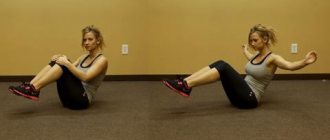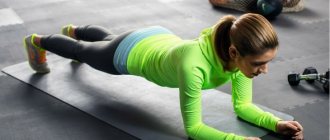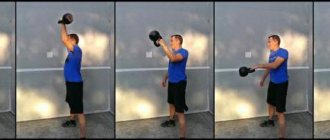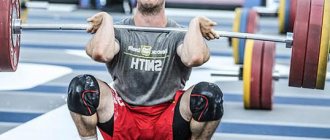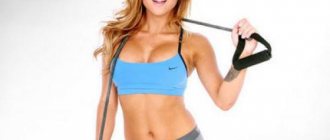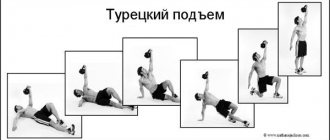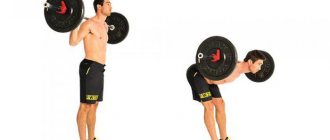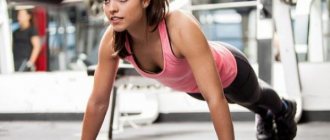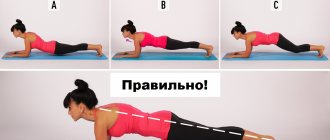Rules for performing the exercise
Each exercise with weights is technically more difficult, so it is imperative to stretch your hands and shoulders well before starting the exercise so as not to injure your joints.
- Before starting the exercise, the kettlebell stands in front of you, feet shoulder-width apart. Take the weight in your hand.
- Swing the weight between your legs and throw it over your shoulder. The elbow of the working hand is pressed to the body. The torso is tilted back slightly to compensate for the weight of the kettlebell.
- Next, perform a squat so that, sharply extending your legs, you tear the weight upward.
- Next, return the kettlebell to your shoulder (springing your legs)
- Lower the weight down towards your groin area.
This is called a long cycle: first the weight is thrown to the shoulder, then the push, then returned to the shoulder and lowered down. Repeat the long cycle the required number of times with one hand, then with the other.
When working for time (usually 1 to 5 minutes), change hands every 5 to 10 repetitions. Find your optimal number of continuous repetitions with one arm. This could be, for example, 6, 7 or 9 repetitions.
Note: The long cycle jerk can be performed with two kettlebells at the same time. You can see the detailed technique for performing the exercise in the following video.
The video says that one of the key points of the exercise is holding the weights on the chest. A good place to start is to develop this skill. Hold two weights on your shoulders statically, maintaining correct technique. The elbows rest against the body, the shoulders are relaxed, the back is tilted back. The hand and forearm form a straight line. When swinging the weights, the body leans forward, the back is straight. Then the weight begins to move down and forward, moving the body back. We place our elbows point-blank. Next comes the kettlebell push. We push the projectile out with our feet, performing a squat. The arms are straightened vertically upward.
The video also explains the variations of this exercise: releasing weights on the shoulders through a support, releasing weights from the top position (a more complicated version, suitable for stronger shoulders), releasing plus a power lift. Choose the most convenient option for yourself.
Jerk
The next exercise in classic kettlebell lifting is the kettlebell snatch.
The snatch can, as described above, be included in the classical combined event program along with the clean and jerk - for men - or be represented as a separate competitive exercise for women.
The snatch, unlike the clean and jerk, is performed with one kettlebell for 10 minutes with each hand alternately. When performing a snatch, only one change of hands is allowed.
So, jerk.
When performing a snatch, the athlete begins the movement from the initial “kettlebell down” position. In the trajectory of movement of the weight in a snatch, we can conditionally distinguish 4 points: the point of swing, the point of detonation of the weight, the point of inserting the hand into the arch of the weight, and the end point - the point of fixation of the hand with the weight.
Let's take a closer look at the entire trajectory of the weight's movement. The swing point is the extreme point from which the forward and upward movement of the weight begins. To perform the exercise most effectively, this point should be located as far back as possible between the athlete’s legs.
This is necessary for maximum inertial force when moving the weight, in order to reduce the load on the arm muscles. So, from the point of the swing, the weight begins an inertial movement forward and upward.
However, the force of inertia is not infinite and the weight sooner or later slows down and stops its inertial movement.
The point at which the inertial force stops moving the weight is the point at which the weight explodes. At this point, the athlete begins to apply his own effort to further lift the projectile. So, what are the actions of the athlete when the trajectory of the weight reaches the detonation point?
When the trajectory of the weight reaches the detonation point, the athlete must make certain efforts to ensure its further movement. At the point of detonation, the athlete makes a sharp reverse movement of the shoulder joint of the arm with the weight back and up, which creates additional force for further movement of the weight.
The next point of movement of the weight is the point where the hand is inserted into the arch. This happens when the projectile is at the level of the athlete's head.
Next comes fine-tuning the hand with the weight and directly fixing it.
- Detonation
- Fixation
- Fixation Rotation of the weight
- Interception of the bow
- Lowering the kettlebell into the backswing
- Interception of the bow
Description of the exercise
The long cycle push of a kettlebell is basic in kettlebell lifting and is one of the most difficult, since it consists of several exercises: lifting a kettlebell to the chest with a swing, pushing a kettlebell with one hand. The exercise is considered more popular among men, but is also suitable for women. In competition, the long cycle clean and jerk is performed by both sexes.
This exercise consists of two independent exercises:
| Raising weights to the chest with a swing | Kettlebell push with one hand |
| A basic exercise in kettlebell lifting, which is aimed at developing the muscles of the shoulder trunk, and also serves as a lead-in exercise to the one-handed kettlebell push, the two-handed kettlebell push, and the full cycle kettlebell push. The exercise involves swinging a weight between your legs and lifting it onto your chest. | A basic competitive exercise in kettlebell lifting, which is aimed at developing endurance and working out the entire shoulder girdle. The one-arm kettlebell push is a more complex exercise and consists of pushing the weight vertically upward; during the push, the legs are squatted, thereby taking the load onto themselves. |
Load by muscle group
The load is indicated on a 10-point scale (the total load is summed up)
| Small of the back | 8 (high) |
| Forearms | 7 (high) |
| Anterior delta | 7 (high) |
| Upper back | 6 (average) |
| Front thigh | 6 (average) |
| Shin | 5 (average) |
| Buttocks | 5 (average) |
| Middle delta | 4 (average) |
| Posterior thigh | 3 (average) |
| Latissimus muscles | 2 (weak) |
| Inner thigh | 2 (weak) |
| Biceps | 2 (weak) |
| Total load/exercise type | 57 (high) / basic global |
| Load on the spine | 8 (high) |
Muscles involved in the exercise
Let's look at what muscles work when performing a long cycle push of a kettlebell. During the kettlebell push, a large number of different muscle groups work, the main load falls on the deltoid muscles and leg muscles. The triceps, biceps, forearm, quadriceps, gluteal muscles, trapezius muscles, upper back, and core muscles (lumbar muscles and abs) play a supporting role.
Some muscles work more, some less, which, in particular, depends on the technique of performing the push, but, nevertheless, the push allows you to work almost the entire body. It is especially important to practice coordination of movements, their synchronization and sequence, so as not to get confused and not cause injury to yourself.
Important points
To ensure that your training brings only positive results, pay attention to a few simple recommendations:
- Do not allow your wrist to bend or straighten while doing presses. Your wrist is in line with your forearm - this is a necessary condition for the safety of the ligaments and joint.
- Keep your entire body tense as you move. There should be no relaxation in the legs, buttocks or body.
- Don't be fanatic about choosing the weight of the weights. A machine that is too heavy will prevent you from performing the exercise correctly and create a risk of injury. The market offers a huge number of options for dumbbells - for any color and size. Remember that a 32 kg kettlebell press can be done by a trained athlete, but not by a beginner who has not previously engaged in strength sports.
- Pay attention not only to strength exercises, but also to stretching. It will make the muscles and ligaments more elastic, the movements will become cleaner, and the technique will be much easier to master.
- In this exercise, try to avoid jerking. Raise the projectile under control and lower it under control.
Even if you have previously trained your shoulders with dumbbells or a barbell, adding kettlebell lifts to your program will create an unusual load on the muscles, thereby creating an impulse for their growth and increase in strength.
Rank standards and records
The long cycle kettlebell jerk is a challenging competitive exercise. Below are the category standards for men and women, as well as Russian records among men with a 32 kg kettlebell.
TABLE OF DIFFERENT STANDARDS FOR MEN:
DC push (number of weight lifts in 10 minutes)
| Weight category (kilogram) | MSMK kettlebell 32kg | MS kettlebell 32kg | KMS kettlebell 32kg | I weight 24kg | II kettlebell 24kg | III kettlebell 24kg | I(u) kettlebell 16kg | II(u) kettlebell 16kg | III(u) kettlebell 16kg |
| 48 | — | — | — | — | — | — | 40 | 35 | 30 |
| 53 | — | — | — | — | — | — | 48 | 42 | 36 |
| 58 | — | — | — | 55 | 45 | 35 | 55 | 48 | 40 |
| 63 | 59 | 44 | 35 | 60 | 49 | 39 | 61 | 51 | 42 |
| 68 | 72 | 56 | 45 | 65 | 54 | 43 | 66 | 56 | 46 |
| 73 | 76 | 62 | 48 | 70 | 58 | 46 | 71 | 61 | 51 |
| 73+ | — | — | — | — | — | — | 74 | 64 | 54 |
| 78 | — | — | — | 74 | 62 | 50 | — | — | — |
| 85 | 82 | 69 | 55 | 79 | 66 | 54 | — | — | — |
| 85+ | 88 | 75 | 58 | 90 | 75 | 60 | — | — | — |
TABLE OF DIFFERENT STANDARDS FOR WOMEN:
DC push (number of weight lifts in 10 minutes)
| Weight category (kilogram) | MSMK kettlebell 24kg | MS kettlebell 24kg | KMS kettlebell 24kg | I weight 16kg | II kettlebell 16kg | III kettlebell 16kg |
| 63 | 59 | 44 | 35 | 60 | 49 | 39 |
| 63+ | 72 | 56 | 45 | 65 | 54 | 43 |
Records of Russia. Men (long cycle) - kettlebell 32 kg.
| Weight category | Last name, first name | Region | Result | Year of establishment |
| 63 | Ryabkov Alexey | Tyumen region | 74 | 2015 KR |
| 68 | Usoltsev Alexander | Tyumen region | 80 | 2015 CR |
| 73 | Belyaev Ivan | Belgorod region | 87 | 2014 World Cup |
| 78 | Chuev Pavel | Belgorod region | 84 | 2017 CR |
| 85 | Vasiliev Denis | Saint Petersburg | 91 | 2014 World Cup |
| 95 | Balabanov Sergey | Rostov region | 93 | 2017 KR |
| St. 95 | Denisov Ivan | Chelyabinsk region | 110 | 2014 World Cup |
Alternative Exercises
The push press is one of the most popular CrossFit strength exercises. It is one of the basic weightlifting exercises that works large muscle groups and also develops coordination and flexibility.
Press press
Military kettlebell press with two hands. The military press is one of the best exercises for the entire shoulder core, and the kettlebell, as an unusual apparatus, helps develop coordination of movements.
Military two-hand kettlebell press
Clean and push. To perform this exercise you will need a barbell. The exercise is complex and quite difficult. Lift the barbell off the floor through a squat. When the bar reaches your knees, quickly lift the barbell toward your chest. The bar rests on the front of the shoulders. Straighten up completely and, as you exhale, press the barbell overhead.
Clean and jerk
Auxiliary exercises
Lifting the weights onto the chest with a swing. The exercise is a component of the long cycle push of the kettlebell, and also serves as a leading exercise to the exercise in question. It is aimed at developing the muscles of the shoulder body.
Raising weights to the chest with a swing
The one-arm kettlebell snatch is also an auxiliary exercise for TDC. Volumetrically works the rectus dorsi muscles for casting; the hand is most intensively loaded for the same. Something like “aerobic exercise” during the development of general endurance for a long cycle push.
One-arm kettlebell snatch
Classic push
The classic clean and jerk, along with the kettlebell snatch, is part of the kettlebell double event. The exercise is performed as follows: after the command
“Start” the athlete throws the weights onto his chest and begins lifting them up. The competition goal is to complete the most lifts within 10 minutes. I would like to describe some of the nuances of this exercise, namely the position of the hands, the position of the legs, the position of the weight in the palm.
So, at the beginning of the push, the athlete is in the starting position, the weights are on the platform in front of the athlete. At the “Start” command, the athlete throws weights onto his chest and begins lifting.
To begin with, I would like to talk about the position of the weight in the athlete’s palm.
When throwing, the weight should be positioned in the palm of your hand in such a way that the possibility of it falling out during the exercise is excluded. The only correct option for the location of the weight is, so to speak, a diagonal arrangement in the palm: the bow of the weight is located diagonally - the base of the index finger of the hand - the base of the palm. It is with this arrangement of the bow that involuntary displacement or loss of the projectile is completely eliminated. It should be noted that this position of the arch is similar when performing all kettlebell lifting exercises.
Further, after throwing, or rather simultaneously with throwing weights onto the chest, the athlete sets his elbow joints in such a way as to most effectively use them as levers during the lifting process. The elbow joints are installed on the iliac crests. In this position, the arms are most resistant to the load and are most effectively used when pushing weights. A good option for those athletes whose arm length does not allow the elbow joint to be positioned correctly is to use a weightlifting belt. The upper edge of the belt in this case will also be a good basis for placing the elbow joints.
I would like to say a few more words about the positioning of the legs in the clean and jerk.
The legs should be positioned in such a way as to ensure the greatest efficiency of work, namely pushing. Since the legs are also used as levers, they need to be installed in such a way that all the force when pushing goes upward. Thus, the most effective position will be to position your feet shoulder-width apart or slightly narrower. In this position, all the pushing force will be directed upward.
So, when performing a push, the athlete from the initial position “weights on the chest, legs shoulder-width apart” performs a small half-squat, followed by a sharp push with the legs and a simultaneous whipping forward-upward movement of the pelvis, thereby transferring the force to the elbow joints and pushing the arms with the weights up. Simultaneously with the hands with the weights reaching the end point at the top, a second, deeper squat is performed. This is necessary to make the work of the hands easier - as if the athlete is diving under the weights. Next, the legs are straightened and the weights are briefly held above the head in the fixation position, with further lowering to the chest for the next lift.
